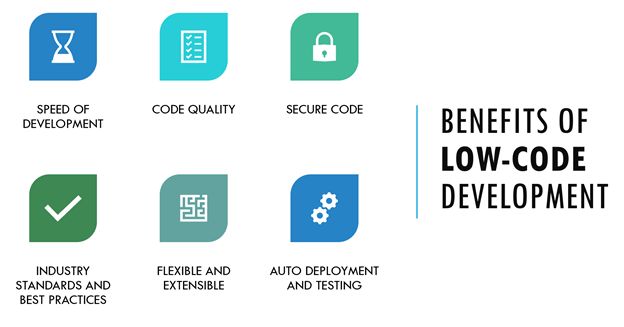Good Advice To Deciding On Low-code platforms for application development
Good Advice To Deciding On Low-code platforms for application development
Blog Article
Benefits Of Low-Code Application Development In Terms Of Integration Capabilities
Low-code application integration offers many advantages, including the capability to seamlessly integrate various platforms and services. Here are a few major advantages: Pre-built connectors and APIs.
A Wide Variety of Connectors Low-code platforms usually come with a vast library of pre-built connectors for popular enterprise systems (e.g. ERP, CRM and cloud services such as databases,). Integration of the systems can be made much easier.
API Integration - Many low-code platforms come with API integration, which gives developers to easily access external services or data sources.
Ease of Use:
Drag-and--Drop integration: Integration tasks are often done using drag and drop interfaces. Developers and non-developers can set up complex integrated systems without having to write code.
Visual Workflow Designers: These tools help you understand and configure integrations with more ease.
Standardized Integration Methods:
SOAP and RESTful Service : The support for web services standards such as REST and SOAP makes it easy to integrate with many external systems.
OData Other Standards The support for standards like OData allows transfer and manipulation of data across platforms and applications.
Real-Time Data Synchronization:
Real-Time Integrations: Lowcode platforms handle data synchronization in real-time between the system and applications to ensure that data is current and consistent throughout an organization.
Event-Driven Architectures: Certain platforms have event-driven architectures which allow applications to respond in real-time whenever certain events happen, which is vital for dynamic applications.
Legacy System Integration:
Interconnecting Old Systems and New Systems Low-code platform often provides the tools needed to integrate with old systems. This allows companies to upgrade their IT Infrastructure without overhauling the current systems.
Data Migration Tool: Built-in tools allow the data to be transferred from legacy systems into new applications that are built on low-code platforms.
Third-Party service integration:
Cloud Services Integration: The seamless integration of cloud services, like AWS Azure, Google Cloud makes it easy to deploy and scaling-up of applications.
Business Application Integration: Low-code platforms can connect to various business applications, such as Salesforce, SAP, Microsoft Dynamics and more. This allows for a seamless workflow that is able to be used across various business functions.
Simple Data Management:
Unified Data Modells: Some lowcode platforms provide common coding models, which make it easier to manage managing data and integration, as well as synchronization across various platforms.
Data Connectors are pre-configured data connectors that offer quick access to data sources and allow manipulation.
Security and Compliance
Secure Integrations - Low-code platforms are designed to make sure that integrations adhere to security standards and protocols. This protects information both during its travel and when it is being stored.
Security Features: These platforms typically contain features that ensure the integrations are compliant with regulatory requirements (e.g. GDPR, HIPAA), providing assurance for companies that handle sensitive information.
Extensibility:
Custom Code and Scripts: For more complicated integration requirements low-code platforms usually permit the integration of custom scripts and code that allow for flexibility, without compromising accessibility of the.
Plug-in Ecosystems. A community of extensions and plug-ins will allow you to further enhance the integration capabilities, and add new features whenever you need to.
Overall, the low-code platform's capabilities for integration makes it an effective tool to create interconnected applications that are efficient and scalable. They simplify the process of connecting disparate systems, enhance data flow and allow enterprises to embrace new technologies while leveraging existing ones. Have a look at the top Low-code Platform for application development for site tips including rapid action development, develop web application, develop cross platform mobile app, rad application development, rapid applications, build with docker, build a docker container, software for app development, azure sql, cross platform app development and more.
The Benefits Of Low-Code Development In Terms Of Scalability, Flexibility And Scalability
The creation of low-code applications has many benefits, especially in terms scaling. It is crucial to create applications that develop with your business and can adapt as it changes. Here are a few of the main advantages.
Cloud-based deployment. Many low-code platforms have a cloud-based implementation, which allows users to easily scale their applications by using cloud infrastructure. Businesses can handle higher loads without having to worry much about the administration of servers.
Auto-Scaling Functions: Auto scaling functions are able to automatically adjust resources according to demands. They make sure that performance is constant at peak times.
Flexible Architecture:
Low-code platforms facilitate modular designs where components can independently be designed, evaluated and scaled. This modularity improves flexibility and enables easier modifications or expansions to specific components without affecting the entire system.
Microservices Architecture: The Microservices architecture enables the development of applications by creating an loosely coupled collection of services. This allows for greater capacity and flexibility.
Customizable Solutions
Flexibility : Low-code platforms enable developers to enhance functions beyond what they are able to provide. This guarantees that specific business requirements can be met without constraints.
Third-Party Integrations: The capacity to integrate with third-party applications and APIs allows companies to integrate additional features and services to enhance the functionality of the application.
Agile Development and Deployment
Continuous Deployment and Delivery: Low code platforms support agile processes, allowing continuous deployment and integration (CI/CD). This allows for rapid deployment of updates and new features, allowing applications to grow rapidly in response to user feedback and changes in the market.
Iterative Development - The low-code method allows applications to be improved and scaled incrementally, reducing risk and allowing for more controlled growth.
Resource Optimization
Efficient resource management: Platform tools that use low-code help optimize resource use by monitoring and regulating the performance of applications. This helps ensure that resources are utilized efficiently and are scalable to meet actual needs.
Load-balancing features that distribute workloads equally across servers improve the capacity of applications to handle large traffic and ensure consistent performance.
Global Reach:
Multi-Region deployment: Low-code platforms are often able to support deployment across different geographical regions. This enables businesses to provide low-latency services to users around the world. This is particularly important for applications that have users from all over the world.
Localization Support built-in support for localization allows applications to easily adapt to various local languages and requirements which allows them to adapt to various markets.
Maintenance and Updates
Simple Maintenance: The visual and modular nature of low-code programs simplify maintenance tasks, allowing updates and bug fixes to be completed quickly and without lengthy downtime.
Version Control: A fully integrated version control system helps control changes and roll backs. This means that updates can be easily deployed and previous versions restored when needed.
Cost Efficiency:
Low development costs. Through reducing the code requirements, low-code platforms cut down on the development cost and permit applications to be scaled up without increasing development effort.
Pay-As-You Go Models: A lot of low-code services offer a variety of pricing models, including pay-as you-go that align costs with actual use and growth, offering financial flexibility.
Overall the scalability, flexibility and scalability benefits of low-code development allow businesses to create robust, adaptable and scalable apps efficiently. These platforms allow quick adjustments to changing demand as well as efficient utilization of resources and constant advancement. Applications can grow and evolve with the needs of the business. Have a look at the best go here about Legacy application modernization with Low-code for more examples including jdbc server, azure sql server, low code development platforms, application modernisation, mobile app development platforms, app development platform, cross platform mobile dev, cross platform mobile app development, database in azure, app platforms and more.
The Advantages Of Low-Code Development To Collaborate And Streamline Workflow
It's a great option for companies that wish to increase team productivity, streamline processes and improve collaboration. Here are the major advantages: Improved Collaboration Across Functions:
Unified Development Environment. Low-code platforms enable all team members to work together in one unifying environment. This includes business analysts, developers and designers as well as stakeholder. This eliminates silos and fosters more effective communication.
Visual Development Tools: The graphic, drag-and-drop nature of low-code platforms makes it easy for team members who are not technical to be involved in the development process and ensure that business requirements are accurately captured and implemented.
Improved Communication
Real-Time Collaboration: Many low-code platforms offer real-time collaboration capabilities including the simultaneous editing of comments and instant feedback. These features facilitate continuous communication and reduce the time wasted in back-andforth discussions.
Shared Workspaces : Teams are able to collaborate within shared workspaces. They can view edit, discuss and even discuss elements of the project. This makes sure that everyone has a common objective.
Streamlined workflow management:
Built-in project management tools Lowcode platforms usually come equipped with integrated tools that aid teams in preparing, tracking and directing their growth. This includes task assignment, progress monitoring, and deadlines management.
Workflow Automation Automating routine tasks or workflows permits teams to concentrate their efforts on more strategic initiatives and tasks and improves the overall efficiency of an organization.
Speedier iteration cycles:
Rapid prototyping: Low-code platforms allow for rapid prototyping, iterative development and quick prototyping. This allows teams to design and develop applications that are tested, then refine the applications in shorter time. This provides rapid feedback and further improvement.
Support for Agile Methodologies: Using agile practices gives teams the ability to run sprints and continually provide small amounts of functionalities, making it easier to adapt to the changing demands.
Accessibility of Non-Developers
Citizen Development: Low-code platforms give business users the capability to develop and modify applications without coding expertise. This eases the workload of IT and development departments, and allows them to react faster to business needs.
Onboarding and training: The intuitive user interfaces as well as a wealth of training resources help bring new team members up to speed. This improves the overall team's collaboration.
Centralized Documentation & Knowledge Sharing
Integrated Documentation : Low-code platforms offer a wide range of tools which allow the creation and management of documentation within the platform. This will ensure that all project information is easily accessible and located centrally.
Knowledge Repositories. Teams can establish repository of knowledge, with templates and parts that can be reused. This can facilitate knowledge sharing, and reduce duplication.
Consistency in Standardization:
Standardized Components. Utilizing pre-built standard components provides uniformity throughout all software. This makes it easier for team members to learn and collaborate with various parts of projects.
Governance and compliance: Built into governance frameworks that ensure that every development follows organization standards and requirements of the regulatory environment, reducing the risk of non-compliance while ensuring that applications meet high quality standards.
Feedback loops:
Integrated Feedback Systems: Low code platforms have integrated feedback systems that permit users to give feedback to the applications. The feedback can then be used in the development of those applications.
Continuous Improvement: The capability for applications to quickly iterate and make changes on the basis of feedback, ensuring that they are closely aligned with the requirements of the user as well as the business goals.
Visualization, Reporting and Analysis
Real-time Analytics: In-built analytics and reporting provide real time insights into project performance, user interactions and progress. Decision-making based on data is possible.
Visual Workflow Maps: Tools for mapping workflows or processes are useful for teams to understand their processes. They can also be used to pinpoint bottlenecks, and areas that need improvement.
Overall, the advantages of low-code application development in terms of collaboration and workflow lie in its ability to connect diverse teams as well as streamline communication and also automate processes. This leads to more effective and agile development environment that is collaboration-oriented.